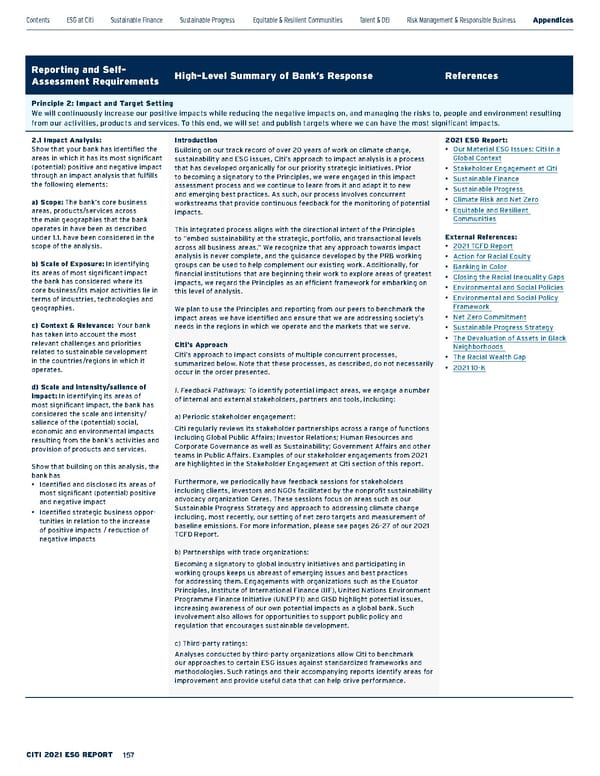Reporting and Self- Assessment Requirements High-Level Summary of Bank’s Response References Principle 2: Impact and Target Setting We will continuously increase our positive impacts while reducing the negative impacts on, and managing the risks to, people and environment resulting from our activities, products and services. To this end, we will set and publish targets where we can have the most significant impacts. 2.1 Impact Analysis: Show that your bank has identified the areas in which it has its most significant (potential) positive and negative impact through an impact analysis that fulfills the following elements: a) Scope: The bank’s core business areas, products/services across the main geographies that the bank operates in have been as described under 1.1. have been considered in the scope of the analysis. b) Scale of Exposure: In identifying its areas of most significant impact the bank has considered where its core business/its major activities lie in terms of industries, technologies and geographies. c) Context & Relevance: Your bank has taken into account the most relevant challenges and priorities related to sustainable development in the countries/regions in which it operates. d) Scale and intensity/salience of impact: In identifying its areas of most significant impact, the bank has considered the scale and intensity/ salience of the (potential) social, economic and environmental impacts resulting from the bank’s activities and provision of products and services. Show that building on this analysis, the bank has • Identified and disclosed its areas of most significant (potential) positive and negative impact • Identified strategic business oppor - tunities in relation to the increase of positive impacts / reduction of negative impacts Introduction Building on our track record of over 20 years of work on climate change, sustainability and ESG issues, Citi’s approach to impact analysis is a process that has developed organically for our priority strategic initiatives. Prior to becoming a signatory to the Principles, we were engaged in this impact assessment process and we continue to learn from it and adapt it to new and emerging best practices. As such, our process involves concurrent workstreams that provide continuous feedback for the monitoring of potential impacts. This integrated process aligns with the directional intent of the Principles to “embed sustainability at the strategic, portfolio, and transactional levels across all business areas.” We recognize that any approach towards impact analysis is never complete, and the guidance developed by the PRB working groups can be used to help complement our existing work. Additionally, for financial institutions that are beginning their work to explore areas of greatest impacts, we regard the Principles as an efficient framework for embarking on this level of analysis. We plan to use the Principles and reporting from our peers to benchmark the impact areas we have identified and ensure that we are addressing society’s needs in the regions in which we operate and the markets that we serve. Citi’s Approach Citi’s approach to impact consists of multiple concurrent processes, summarized below. Note that these processes, as described, do not necessarily occur in the order presented. 1. Feedback Pathways: To identify potential impact areas, we engage a number of internal and external stakeholders, partners and tools, including: a) Periodic stakeholder engagement: Citi reg ularly reviews its stakeholder partnerships across a range of functions including Global Public Affairs; Investor Relations; Human Resources and Corporate Governance as well as Sustainability; Government Affairs and other teams in Public Affairs. Examples of our stakeholder engagements from 2021 are highlighted in the Stakeholder Engagement at Citi section of this report. Furthermore, we periodically have feedback sessions for stakeholders including clients, investors and NGOs facilitated by the nonprofit sustainability advocacy organization Ceres. These sessions focus on areas such as our Sustainable Progress Strategy and approach to addressing climate change including, most recently, our setting of net zero targets and measurement of baseline emissions. For more information, please see pages 26-27 of our 2021 TCFD Report. b) Partnerships with trade organizations: Becoming a signatory t o global industry initiatives and participating in working groups keeps us abreast of emerging issues and best practices for addressing them. Engagements with organizations such as the Equator Principles, Institute of International Finance (IIF), United Nations Environment Programme Finance Initiative (UNEP FI) and GISD highlight potential issues, increasing awareness of our own potential impacts as a global bank. Such involvement also allows for opportunities to support public policy and regulation that encourages sustainable development. c) Third-party ratings: Analyses cond ucted by third-party organizations allow Citi to benchmark our approaches to certain ESG issues against standardized frameworks and methodologies. Such ratings and their accompanying reports identify areas for improvement and provide useful data that can help drive performance. 2021 ESG Report: • Our Material ESG Issues: Citi in a Global Context • Stakeholder Engagement at Citi • Sustainable Finance • Sustainable Progress • Climate Risk and Net Zero • Equitable and Resilient Communities External References: • 2021 TCFD Report • Action for Racial Equity • Banking in Color • Closing the Racial Inequality Gaps • Environmental and Social Policies • Environmental and Social Policy Framework • Net Zero Commitment • Sustainable Progress Strategy • The Devaluation of Assets in Black Neighborhoods • The Racial Wealth Gap • 2021 10-K Contents ESGatCiti SustainableFinance SustainableProgress Equitable&ResilientCommunities Talent&DEI RiskManagement&ResponsibleBusiness Appendices ESGS ataC ius niblnG 157
 Citi ESG Report Page 156 Page 158
Citi ESG Report Page 156 Page 158